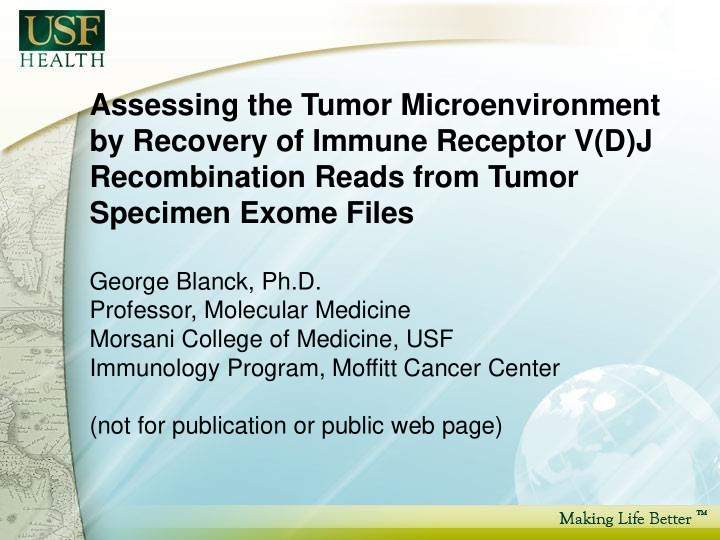



Assessing the Tumor Microenvironment by Recovery of Immune Receptor V(D)J Recombination Reads from Tumor Specimen Exome Files George Blanck, Ph.D. Professor, Molecular Medicine Morsani College of Medicine, USF Immunology Program, Moffitt Cancer Center (not for publication or public web page)
Learning objectives: 1. To appreciate the availability of T-cell receptor recombination information from tumor specimen DNA samples. 2. To understand the correlation between T-cell receptor recombinations, in tumor specimen DNA, and other, clinically relevant information for bladder cancer and kidney renal cell carcinoma. 3. To understand the importance of HLA alleles in assessing the impact of T-cell receptor recombinations from tumor specimen DNA.
Fig. 1. Immune receptor genes recombine during development to generate many different receptor molecules among the B-cells and T- cells, throughout the body, through life, to bind many different antigens, including tumor antigens.
Seven immune receptor genes total: • Three related to antibodies, not further discussed. • Two related to gamma-delta T-cells, not further discussed • Two required for alpha-beta T-cells, the subject of this presentation.
Alpha-beta T-cells: • Most numerous. • Best understood, medically speaking. • Generally target peptide antigen, in the case of tumors, a mutant peptide. • The TRB part of the TRA/TRB receptor is considered most important in antigen binding.
The tumor specimen and the exome • Surgically remove tumor, obtain DNA sequence (all exons = exome), for tumor mutations, which can guide therapy. • Other cells in the specimen, particularly T-cells. • The DNA representing the T-cell receptor can be identified above the tumor DNA “background”.
Fig. 1 again.
Tabulate, millions and millions, along with clinical information: TCGA BLCA Number Reads Clinical status V usage D usage J usage of reads Barcode detected TCCCAGACATCTGTGTAC No subsequent TTCTGTGCCAGCAGTGCC 7 tumor/positive TRBV10-3 TRBD1 TRBJ1-2 TCGA-FD-A5BS CGGACAGGGAAGTATGG CTACACCTTCGGTTCGGG outcome GACCA AGCCCCAACCAGACCTCT No subsequent TRBV27- CTGTACTTCTGTGCCAGC 20 tumor/positive TRBD2 TRBJ2-7 TCGA-FD-A5C1 AGTTTATCGGGCGGGGG 01 AGTATACGAGCAGTACTT outcome CGGGC
Results 1. For bladder cancer, the more TRB recombination reads, the better the outcome. 2. For melanoma and renal cell carcinoma, the more TRA and TRB reads, the higher the levels of immune checkpoint protein expression. 3. For certain cancers, the combination of usage of a particular V or J segment, by T-cells in the tumor microenvironment, and a particular HLA type, corresponds to a dramatic survival distinction.
Data collection redacted in anticipation of separate publication.
Fig 3. The T-cell receptor binds to antigen by simultaneously binding the HLA molecules on other cells.
References for preceding slides, results • Anne Mai et al submitted • Kendall Clark et al in prep
The future: • Exome detectable TcR recombinations, that correlate with survival or immune checkpoint protein expression are likely to be of use in settings where cost-efficiency is paramount, or as a confirmation. • Linking TcR gene segment usage to HLA alleles for prognosis may be doable, routinely, with exome based recovery of TcR recombinations, particularly in settings where cost-efficiency is paramount; or, TcR segment usage may be more reliably assessed with other methods, for matching to HLA alleles.
Question: What is the surrogate for detection of tumor microenvironment T-cells, when relying on an exome file? A. HLA allele sequence B. Oncogene mutations C. PD1 D. V-J recombination read
USF research group USF research computing Wei Lue Tong Dr. Timothy Fawcett Yaping Tu Blake Callahan Anne Mai Jacob Kinskey Dhiraj Sikaria Seyed Ahmad Falasiri Diana Fisler Moffitt Collaborators John Yavorski Tasnif Rahman Wade J. Sexton Kendall Clark Domenico Coppola Tommy Gill Minjung Kim Jay Patel
Recommend
More recommend